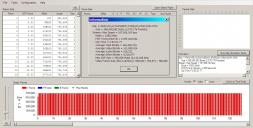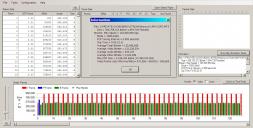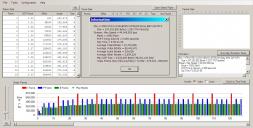
AVCHD maximum image quality, series 2
-
@cosimo_bullo
Thank you always! I respond to your request. :-)
Of course, I have also already tried his patch before travel.
I liked the extreme setting as you knew, but his set was too going too far to completely use FOR ME truly.
Many frames have fallen at the time of the practical highest stress which I assume.
Although I am thinking the character under lowlight as important, I think that balance is important.
If used only under limited conditions, I will also think that his patch is very attractive. -
@bkmcwd - When you have a chance to look at/ play with Henry O's new gop3 patch I'd love to hear your thoughts. We're having very good results with that patch for shadow clarity, but it's so far quite unreliable.
-
After 3days travel, I came back to the house. :-)
@Stray
Probably I also regard my 154M set as the ability of neither ETC nor the 80% mode to be tested under high stress.
However, it is although I do not think that I would like to raise QP in order to be able to use these... ;-)
@Ralph_B
Thank you very much for your wonderful test!
I am satisfied with the result of your test.
Although, as for the set of Q10, frame size should become larger, did you test it?
@sohus
Thank you for testing my patch!
What is QP or AQ in your new 154M GOP3 patch which survives your test?
By the test of my past, if it is Q14 or more than Q16, also not AQ3 nor AQ4, it turns out that the form of cadence at the time of super-high stress does not become a flat line easily, but since I am thinking as important the practical use level, especially lowlight, I am using Q12 and Q10 or AQ3.
I do not feel a problem at all on these practical use.
Although it becomes behavior also with AQ3 same flat cadence under super extream stress, since frame size becomes small from Q10 AQ3 at the time of lowlight, I like Q10 version. -
Low level format of the SD cards worked the first time and failed in subsequent recordings. The only card that has been working for me without a write failure is SanDisk Extreme HD class 10 SDHC with 30MB/s speed (NOT the UHS-I pro). I tried UHS-I pro 45mb/s and failed. My settings are 24p at 66M/48M and FSH at 32M/24M. I have tried 80%, 160%, 200% and 300% with no failures. Also I can play back in camera too.
-
Most tests were not created for the Sandisk but on the Sandisk.
Also, I see future cameras leveraging the UHS-1 cards so I don't think it is a very wise investment to buy heavily into the Extreme Pro cards now. Most patches run fine on the Transcend, only @bkmcwd and @henryolonga's new patch have serious problems on the Transcend card, but they are extreme settings.
I am sure @Stray's 88M was never created with SanDisk Extreme in mind. I will retest the two patches mentioned above once I get my card, all other patches run fine on the Transcend so no need to retest. -
@sohus. Are you testing all these on a Transcend card and not the Sandisk card most of the tests were created for? If so you might want to retest after you get the Sandisk 30MB/s card. If nothing else it's better to have the same testing protocol that the patches were created with. Otherwise it muddles the process.
-
@stray I took your dense chart, imported it in After Effects, and put a 'Wigglerama' filter on it that zooms, scales, rotates in variable speeds and intervals. I was not sure if it would work but so far I have crashed many patches that survived my regular Death Chart test just fine. I loop it and do 2min - 4min tests. So far, it has resulted in memory card speed errors for many patches. I am pretty confident that it does work as I hoped for that reason. I have an iMac 27" high res screen. I test them using the 14-140mm lens at 25mm, F/5.6 and ISO800 (and 1600).
I think this test is as extreme as it can get. But because it is indoors, lit by my monitor and an AE project, it is very easy to test every new patch this way and compare results.
@Driftwood's GOP1 patches survive it just fine, his GOP3 132M fails (also on static Deathchart)
@Cbrandin's GOP12 patches survive it just fine (MAX VAR as well)
@Sohus' new 154M GOP3 patch (based on foundation of H. Olonga's patch) survives it just fine
@bkmcwd has to wait, as my Transcend doesn't like it, so I ordered a 8GB SanDisk Extreme for test purposes, arriving tuesday. I also hope to improve upon my modification of Olonga's patch to get it stable with that card. -
@sohus What is the motion death chart ?
-
@sohus
The notes say: bkmcwd 154&154MB 3GOP Q=12 FBx3 FLx1 TBx8.6 VB3.6
When I downloaded it, I put the date Oct 9, 2011 on it. Hope that helps. -
@stray
FYI: I have tried both the 0x24 and 0x36 setting and both fail. I just did a 4 minute run on my motion death chart and the cadence was all over the place. It failed to hold up. -
@sohus Yep, I'm onto it, and the ETC/80% problems. I'm pretty sure I can fix both and tighten it all up, but it will take about a week or so with my other commitments at the moment.
-
-
@Stray 88M can become unstable (in controlled testing). I have made a motion deathchart in After Effects and I get occasional drop-outs with Stray's 88M patch. It only happens once in a while but it indicates a buffer overrun. I see it in other patches too, where you get one or 2 frames that are like 10k in size.
-
Bkmcwd's (1)
Drifwood's (2) -
More HDMI Testing - BATTLE OF THE TITANS
It's come time to test the high end contenders against the absolute reference - lossless HDMI output. This was a punishing nighttime test at ISO 6400. HDMI capture was done simultaneously with in-camera recording. The lineup:
Driftwood's 176M GOP1
bkmcwd's 154M GOP3
Stray's 88M GOP12
These are Photoshop TIFs with layers. HDMI is on the bottom, AVCHD on top. Toggle the top layer on and off and compare the two.
[url]http://www.sendspace.com/file/spv5b4[/url]
[url]http://www.sendspace.com/file/ithhfj[/url]
[url]http://www.sendspace.com/file/jdsfrp[/url]
IMPRESSIONS:
It's a tie between bkmcwd's 154M GOP3 and Driftwood's 176M GOP1. Both are perfection. I don't believe you can get any closer to the the HDMI than these two patches. Stray's 88M comes close, very close. And at half the data rate, it's a viable option for high end recording.
EDIT:
I have since run these clips through stream parser.

 Night Test Diftwood 176M.jpg1283 x 648 - 199K
Night Test Diftwood 176M.jpg1283 x 648 - 199K
 Night Test bkmcwd 154M.jpg1283 x 648 - 199K
Night Test bkmcwd 154M.jpg1283 x 648 - 199K
 Night Test Stray 88M.jpg1283 x 648 - 193K
Night Test Stray 88M.jpg1283 x 648 - 193K -
My camera is going to be on the shelf for a bit as I have some music I have to work on for somebody, but if I get a chance I'll get back to this issue. One thing you can try @PixCanFly as it seems you can recreate the problem consistently is to change the video buffer 24p back to 0x2400000, which is under Patchers for testers>AVCHD movie mode>AVCHD Research. It was stable at that setting anyway, I changed it up to 3600000 based on what I think now was incorrect information (a belt and braces decision).
-
@PixCanFly I really cannot recreate the problem with ETC mode that you get, and with the same card too. The image quality of the 176M isn't actually that different. If you look at stills in post of the same scene and push the image a lot, the size of the blocks are actually the same as the 66M AQ2 GOP12 settings. The I-frames themselves are quite a bit smaller with the 176M. However, the motion of GOP1 is breathakingly good, but when it comes to post work it's actually no better. http://personal-view.com/talks/discussion/comment/18767#Comment_18767 the motion does make it look amazing, but it doesn't actually mean the image quality is better in terms that relate to post work (grading, compositing, colour correction etc).
But if you are doing a lot of heavy post work, and you aren't transcoding your footage first to another intra format then the GOP1 will be better everytime as it won't suffer the generational loss as badly as a long GOP stream. If you love the look of the 176M GOP1 though I'd say stick with it, you'll only be constantly hankering after it's look now you've experienced it shooting everytime that you use other settings. ;) Actually the codec is doing more work arguably with a longer GOP than GOP1 really (creating spatially based I-Frames alone is probably a lot easier than creating B and P temporally based frames), maybe thats the problem/difference with the 88M settings. -
@ Stray
Today I experimented with Driftwood 176 GOP1 v3. I was expecting write error with the Sandisk Extreme Pro 45m/s, but instead it recorded and playback fine. It's the same card that gave me problem with your 88M setting the day before.
As a test, I shot Driftwood 176M with ETC and without ETC. I shot the same scene again, the scene that failed me yesterday with the 88M setting. The 176M recorded fine without error and I can playback the recorded clips perfectly in camera. I then took out the SD card, insert it into a second hacked GH2 with your 88M setting and record the same scene. The recording went well but I couldn't play it back on the camera. So I brought it into my computer and upon playback, I found glitches in the recorded image.
Now Im wondering why, I'm not having problem with the higher bitrate Driftwood 176M setting but rather a lower bitrate setting like your 88M. Given a choice, I really would like to stick to your 88M setting instead because of the good balance between quality and file size.
As for Driftwood 176 GOP1 v3, I must say the image quality is breathtaking. My GH2 suddenly look like a camera that is worth 10 to 20 times the price I paid for. -
Thanks stray. I'm going to keep your 88m loaded on my camera despite the occasional card speed error. It seems to be the best compromise between motion quality, image quality, and file size.
-
Clarification. I'm not going to try and fix card speed errors as they are probably card speed errors. It's when you don't get the speed error, but the shot video is still faulty that I'm going to try and sort out. Thats the only real problem, as you think that the shot is fine until you play it back. I still think this is only ETC related, as adding 80% variable speed doesn't create any problem except speed errors with some cards. As I've said I can't replicate it consistently, the patch on the whole is solid with fast cards and also with cards that aren't so fast without 80%.
-
Edited: I found a thread with the most popular patches - http://www.personal-view.com/talks/discussion/953/gh2-patch-vault-most-popular-patches-in-one-place
:) -
Thanks guys. I've though of a couple of things to try, so I'll post results in a day or two. Will hopefully find a way to replicate these problems consistently, but that may take a while to setup.
-
-
@Stray
Testing your 88m with a 32G Dane-Elec 200x SD card, I get the following results:
24H - ETC on, works OK; 80% mode fails with card speed error every time
24L - ETC on works OK; 80% mode occasionaly fails with card speed error, but 2nd attempt always works.
720p - ETC on works OK; 80% mode occasionaly fails with card speed error, but 2nd attempt always works.
Sorry, no streamparser graphs (won't run under Crossover on the Mac)
The Dane-Elec card worked flawlessly for me when I first got it 2 months ago, but the datarates for your settings (and Driftwood's) are much higher than I was using then. Or perhaps the card needs a low-level format, as has been discussed here recently. -
@Stray
Just to be sure that it's not an issue with my Sandisk Extreme Pro 45MB/s, I'll borrow a 'approved' Sandisk 30MB/s extreme to test your 88M again.
Start New Topic


Howdy, Stranger!
It looks like you're new here. If you want to get involved, click one of these buttons!
Categories
- Topics List23,993
- Blog5,725
- General and News1,354
- Hacks and Patches1,153
- ↳ Top Settings33
- ↳ Beginners256
- ↳ Archives402
- ↳ Hacks News and Development56
- Cameras2,368
- ↳ Panasonic995
- ↳ Canon118
- ↳ Sony156
- ↳ Nikon96
- ↳ Pentax and Samsung70
- ↳ Olympus and Fujifilm102
- ↳ Compacts and Camcorders300
- ↳ Smartphones for video97
- ↳ Pro Video Cameras191
- ↳ BlackMagic and other raw cameras116
- Skill1,960
- ↳ Business and distribution66
- ↳ Preparation, scripts and legal38
- ↳ Art149
- ↳ Import, Convert, Exporting291
- ↳ Editors191
- ↳ Effects and stunts115
- ↳ Color grading197
- ↳ Sound and Music280
- ↳ Lighting96
- ↳ Software and storage tips266
- Gear5,420
- ↳ Filters, Adapters, Matte boxes344
- ↳ Lenses1,582
- ↳ Follow focus and gears93
- ↳ Sound499
- ↳ Lighting gear314
- ↳ Camera movement230
- ↳ Gimbals and copters302
- ↳ Rigs and related stuff273
- ↳ Power solutions83
- ↳ Monitors and viewfinders340
- ↳ Tripods and fluid heads139
- ↳ Storage286
- ↳ Computers and studio gear560
- ↳ VR and 3D248
- Showcase1,859
- Marketplace2,834
- Offtopic1,320






